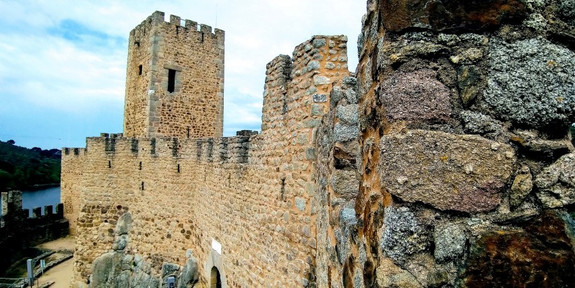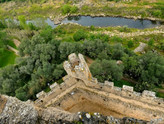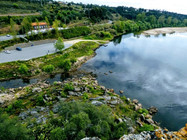Almourol Castle
- soniamelodias

- May 7, 2019
- 6 min read
"Situated on a small steep island, in the middle course of the Tagus river, Almourol Castle is one of the most emblematic and scenographic medieval military monuments of the Reconquista, being at the same time one of the best that evokes the memory of the Templars in our country.
The origins of the occupation of this place are very old and, for that very reason, enigmatic. Some authors have mentioned the possibility of having a primitive Lusitanian or Pre-Roman redoubt, later conquered by them, and with vacancies of occupation throughout the High Middle Ages. In any case, it is certain that in 1129, the date of the conquest of this point by the Portuguese troops, the castle already existed and was denominated Almorolan.
Given to the Templars, who then effected settlement between the Mondego and the Tagus, and even the main ones responsible for the defense of the capital, Coimbra, the castle was rebuilt and assumed the essential architectural and artistic characteristics, which still can be observed today. Through an epigraph, placed on the main door, we know that the completion of the works occurred in 1171, scarce two years after the great work of the Castle of Tomar, built by Gualdim Pais, whose constructive activity at the head of the Order, in the decades of the 60s and 70s of the twelfth century, was truly amazing. There are several characteristics that unite both, in the same line of Templar military architecture. In planimetric terms, the option for a quadrangular arrangement of spaces. In height, the high walls, protected by nine circular towers, adosadas, and the tower of menagem, true center neválálico of all the structure.
These last characteristics are two of the innovative elements with which the Templars guided their military architecture in our country. In fact, as Mário Barroca made clear, the keep is foreign to pre-Romanesque castles, appearing only in the twelfth century and in Tomar, the main Templar defensive stronghold in Portugal (BARROCA, 2001, p.107). The keep of the castle of Almourol was three floors and has been quite modified over time, but still has important original traces, such as the shoe, which gives us the overall dimension of the structure. On the other hand, also the walls with attached towers, usually provided with alambor, were brought to the west peninsular by this Order, and we see them also applied in Almourol.
Once the Order was disbanded, and apart from the reconquisting conjuncture that justified its importance in medieval times, Almourol Castle was voted into a progressive oblivion, which Romanticism came to radically alter. In the nineteenth century, inserted in the mental process of search and revaluation of the Middle Ages, the castle was reinvented in the light of a romantic ideal of medievality. Many of the primitive structures were sacrificed, for the benefit of an ideology that sought to make the most emblematic medieval monuments true masterpieces, unparalleled in heritage heritage. Date, from this height, the uniform crown of merlons and battlements, as well as numerous other elements of an essentially decorative and very impractical nature.
In the twentieth century, the set was adapted to the Official Residence of the Portuguese Republic, here taking place some important events of the Estado Novo. The reinvention process, begun a century earlier, was definitely consummated by this intervention of the 40s and 50s, thus consummating the fascination that Almourol's scenography caused in the long Portuguese cultural and political Romanticism."
Source: IPPAR
Legends associated with the Castle:
"Legend of D. Beatriz and Moiro
In the 9th or 10th centuries, the owner of the castle was a godo called D. Ramiro, married and having a single daughter named Beatriz.
A valiant soldier was, however, rude, proud and cruel as most of the Gothic blood lords. On returning from one of his assaults of war, and proud of his deeds, which were largely confined to innumerable atrocities, he found near the castle two moiras, mother and daughter, who, although infidels, acknowledged to be beautiful as his wife and daughter, your solar.
Distraught of the trip and thirsty, D. Ramiro interjected the moiras to give up the water that the youngest carried in the pool.
Frightened by the figure and tone of voice of the fierce horseman, the little moira let the hammock slip from her hands and breaking, she lost the precious liquid that D. Ramiro so desired.
Bleached and blinded with rage, he suddenly reined the spear and wounded the two wretches who, before they died, cursed him. And because a small 11-year-old mole came along, the son and brother of the murdered made him captive and bring him to the Castle. When Almourol arrived, the young man saw the wife and daughter of D. Ramiro, and vowed to do his revenge on her.
Years have passed. The castellan became ill and gradually faded away until his death, as a result of the poison that had been administered to him by the captive agareno.
The displeasure of the event leads D. Ramiro to seek the struggle against the infidels, refreshing himself for his misfortune and entrusting his daughter's custody to the young Moor, who had made his date, given the docility and courtesy which he had always astutely revealed. It happened, however, that the two young men ignoring the differences of conditions and beliefs soon fell in love, a passion against which the young man fought desperately but in vain, since such love prevented him from consummating his revenge.
But there is no good that always lasts and the rapture and happiness of the two young men are broken by the return of D. Ramiro who was accompanied by another castellan, to whom he had promised the hand of his daughter.
The moiro, then hallucinated and lost, told Beatrice everything about his father's cruelties, the promises of revenge for his mother's poisoning, and the struggle between love and oath he had made.
It is not known what followed this confession. The legend says, however, that Beatrice and the Moire disappeared without any further news. And D. Ramiro, full of remorse and disgust, died shortly afterwards, leaving the castle abandoned. It tells the legend that on certain moonlit nights one sees the moira embraced to D. Beatriz and Ramiro at his feet, always begging for mercy that moiro loosens the word "curse."
In this way the traveler wandering about should not be surprised if, on certain nights of moonlight, he comes to pass through the battlements the white robes of the Templars with the cross of blood on the breast of D. Beatriz and the moire united by a eternal embrace Perhaps he can hear, even amidst the rumor of the waters, the sobs of Don Ramiro.
Legend of Almorolon
In the twelfth century was Lord of Almorol an Arab emir called Almorolon, from which some claim that the Castle took its name.
In him lived a moiro with a daughter, beautiful maiden who adored.
The fates wanted the beautiful young woman to fall in love with a Christian knight, so much so that passion revealed to her the way and the art of introducing him at night to the Castle she had become accustomed to, in repeated amorous incursions, to open the door to his companions which were still waiting for them.
And so was the castle treacherously conquered. But it was a sad and disillusioned victory that the Emir and his daughter, in close embrace, hurled themselves from the walls of the castle to the river, preferring such a death to the captivity resulting from this defeat.
Legend of Assault on Castle
To the Castle came the princesses Miraguarda and Polinarda, with their owners and maidens to whom the giant Palmeirim of England gave hospitality and treated them with the greatest of attention even if they had their prisoners.
Not so much for the beautiful Miraguarda, which nature has shaken of good looks and beauty, but rather by her lady Polinarda, Palmeirim tries to kidnap them and jumps to the esplanade of the castle.
But there was the Sad Knight, winner of the greatest champions of that time and who was in love with Miraguarda.
Challenging Palmeirim for a gun step, he wounded him with palmeirim to be healed of his wounds in a village 3 km from the Castle.
Meanwhile, the Giant Dramusiando, whom Palmeirim had previously won, converted to the Christian faith, had become his friend and companion, having heard from great forces of Almourol, he wanted to measure them with him and won. Dramusiando was then lord of the Castle, and since then he has been guarding the princesses, working wonders of strength and valor."
Source: CM Vila Nova da Barquinha














































































































titi kkkkkkk achas que dá muito nas vistas levar unas pessoas a parte mais alta do castelo .....kkkkkkkk e puf..... que achas